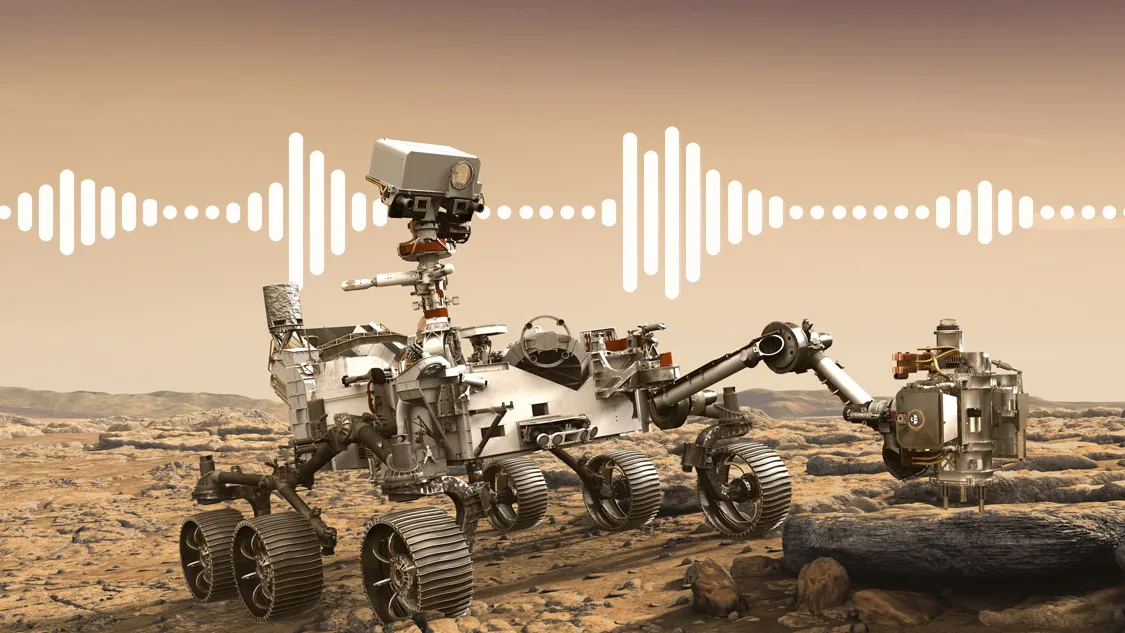
NASA's new Mars rover will be the first to use all five senses
Perseverance will allow us to truly hear the sounds of another planet for the first time.
It's now just days before NASA's new Perseverance rover lands on Mars. This mission features several milestone firsts, but one, in particular, stands out. It will be the first that allows us to use all five senses to explore another planet.
On Thursday, February 18, 2021, at roughly 3:55 p.m. EST, the robot population of Mars is expected to increase by two. At that time, if all goes as planned, NASA's Perseverance rover, and its tiny aerial drone, Ingenuity, will have safely touched down on the Red Planet. Once these two robots get started on their exploration of Jezero Crater, they will send back data about what they see, touch, 'taste', and 'smell'. Also, Perseverance will be the first to allow us to hear the sounds of Mars.
SIGHT
The Perseverance rover carries a total of 18 cameras — five on its mast, ten in various locations on its chassis, and three more on its 'turret hand'. Two of these — the "rover uplook camera" and "rover descent camera" — are specifically there to assist with landing, and are not likely to have a large part in the rover's mission afterward. The Mars Helicopter, Ingenuity, carries two more cameras of its own.
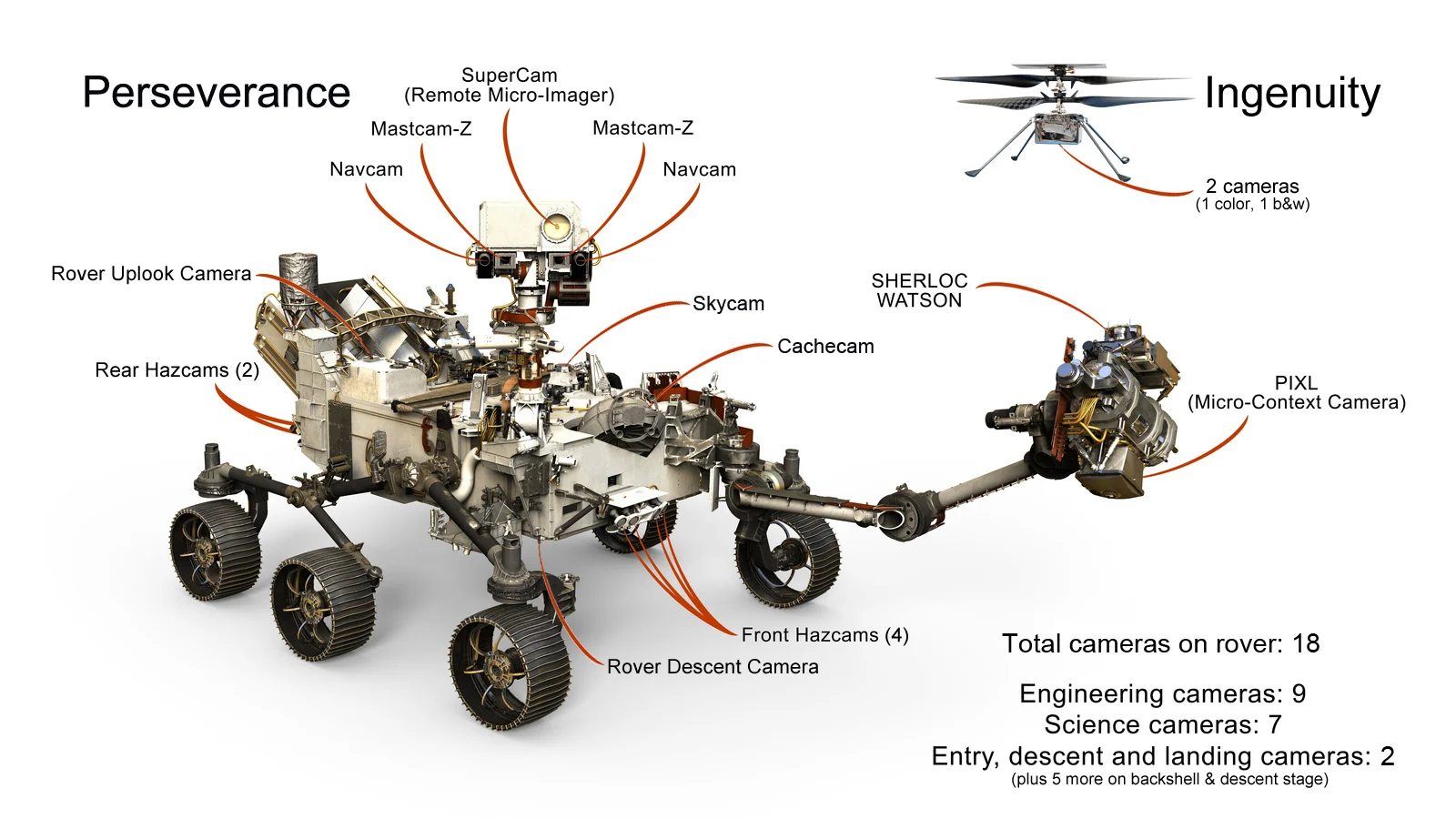
The Perseverance rover's full assortment of cameras are labelled on this diagram, plus those on Ingenuity. Not included here are the 5 cameras mounted on the spacecraft backshell and descent stage, used to support entry, descent and landing. Credit: NASA/JPL-Caltech/Scott Sutherland
Every lander or rover that has touched down on Mars has included one or more cameras. So, this is nothing new. With each mission, the capabilities and resolution of the cameras increased, from Sojourner's 0.4-megapixel navigation cameras (Navcam) to Spirit and Opportunity's 1-megapixel panorama cameras (Pancam) to Curiosity's 2-megapixel mast cameras (Mastcam).
Perseverance can capture HD imagery like Curiosity, but its Mastcam-Z cameras also surpass Curiosity, by adding the ability to record video and zoom in on small or distant targets. Even better, the rover's various engineering cameras will send back 20-megapixel full-colour pictures of its surroundings (compared to 1 megapixel black-and-white from Curiosity). These will be, quite simply, the best images of the surface of Mars we have ever seen.
TOUCH
It goes without saying that by merely having its wheels in contact with the Martian surface, the rover is experiencing touch.
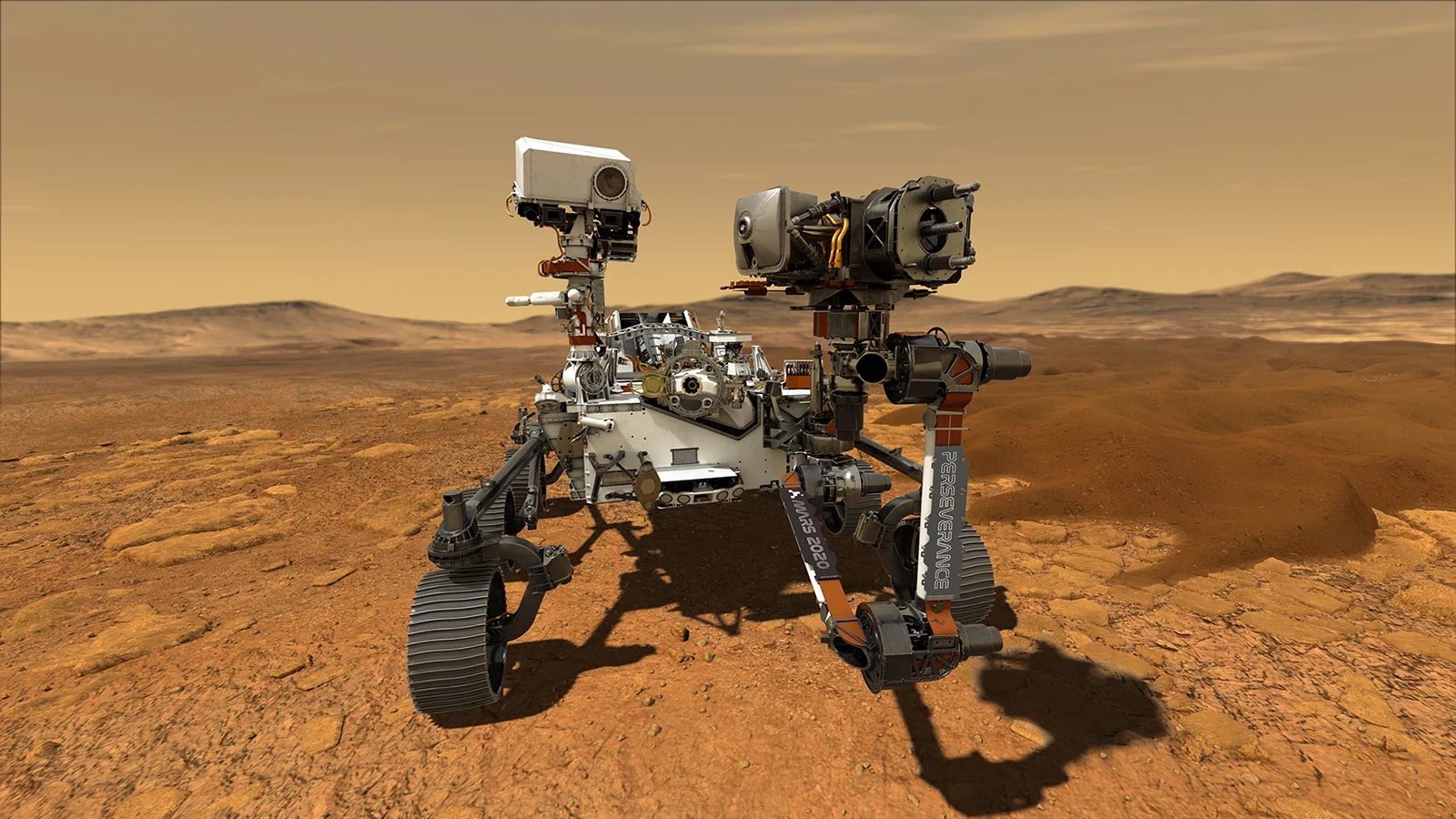
This artist conception drawing of Perseverance on Mars shows off the rover's 'turret hand'. Credit: NASA/JPL-Caltech
However, the 'hand' on the end of Perseverance's robotic arm carries instruments that will touch the surface. The drill contained in the turret will bore into surface rocks and sediments. It can even pick up samples of both the rock and the loose 'regolith' materials. These will be placed into sample collection containers for later missions to pick up and send back to Earth.
For a real 'sense of touch', though, the hand also includes the ground contact sensor, which tells the rover if the arm touches the surface. This sensory feedback will help protect the arm from damage.
'TASTE'
Similar to how we sample the flavours of our food, or how geologists sometimes lick rocks to determine their composition, Perseverance will use chemistry instruments to 'taste' samples on Mars.
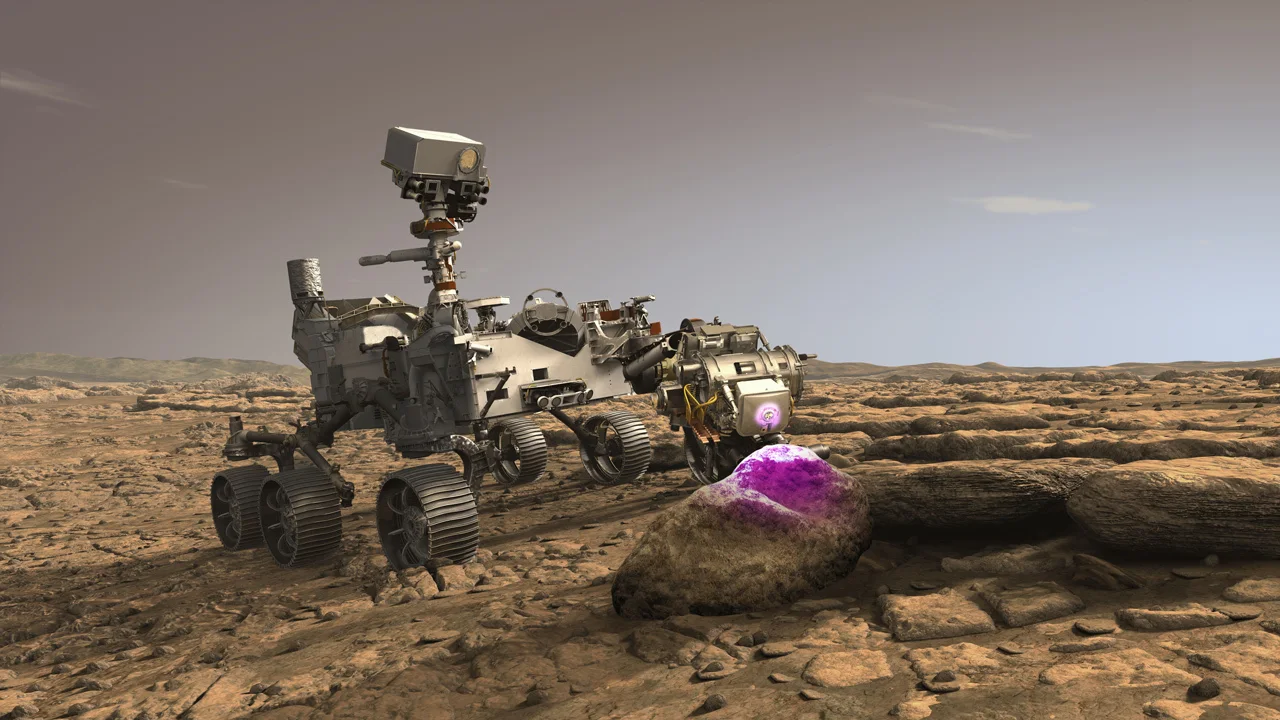
This artist's rendering shows Perseverance using its PIXL instrument on a Martian rock. Credit: NASA/JPL-Caltech
PIXL, or the Planetary Instrument for X-ray Lithochemistry, is a spectrometer located on the rover's arm. Placed right up against a target, the instrument shines laser light onto the target's surface. The light reflected from the surface is then analyzed to determine the chemical composition of the minerals embedded in the rock.
'SMELL'
Perseverance has no nose, as we'd define it. However, the rover's SuperCam instrument, located at the top of its mast, is about as close as a robot can get.

Although it may look like an eye, SuperCam functions more like a nose, vaporizing samples at a distance of up to 20 metres to 'sniff' their mineral composition. This image of Perseverance's mast was taken on July 23, 2019. Credit: NASA/JPL-Caltech
Whereas taste is more about solids and liquids, smell is about gases and vapours.
So, while PIXL will be 'tasting' rocks and other samples for the rover, SuperCam will be approximating the sense of smell by vaporizing its targets. This instrument fires an infrared laser beam, which heats the materials up to 10,000°C, turning it into a vapour that the instrument's camera then images to determine what the target is made of.
In the video below, JPL scientists use SuperCam to zap a metal target, showing off the instrument's capabilities. Listen for the "pop" made by each of the laser's zaps.
HEARING
Speaking of listening, this is going to be a real first for space exploration. In the past, we have heard various 'sounds' from space. However, these have always involved taking some other form of data (like from Voyager's plasma instrument or InSight's seismometer) and converting it to sound. However, thanks to the inclusion of two microphones on the rover, Perseverance will record and send back actual audio recordings of sounds on Mars.
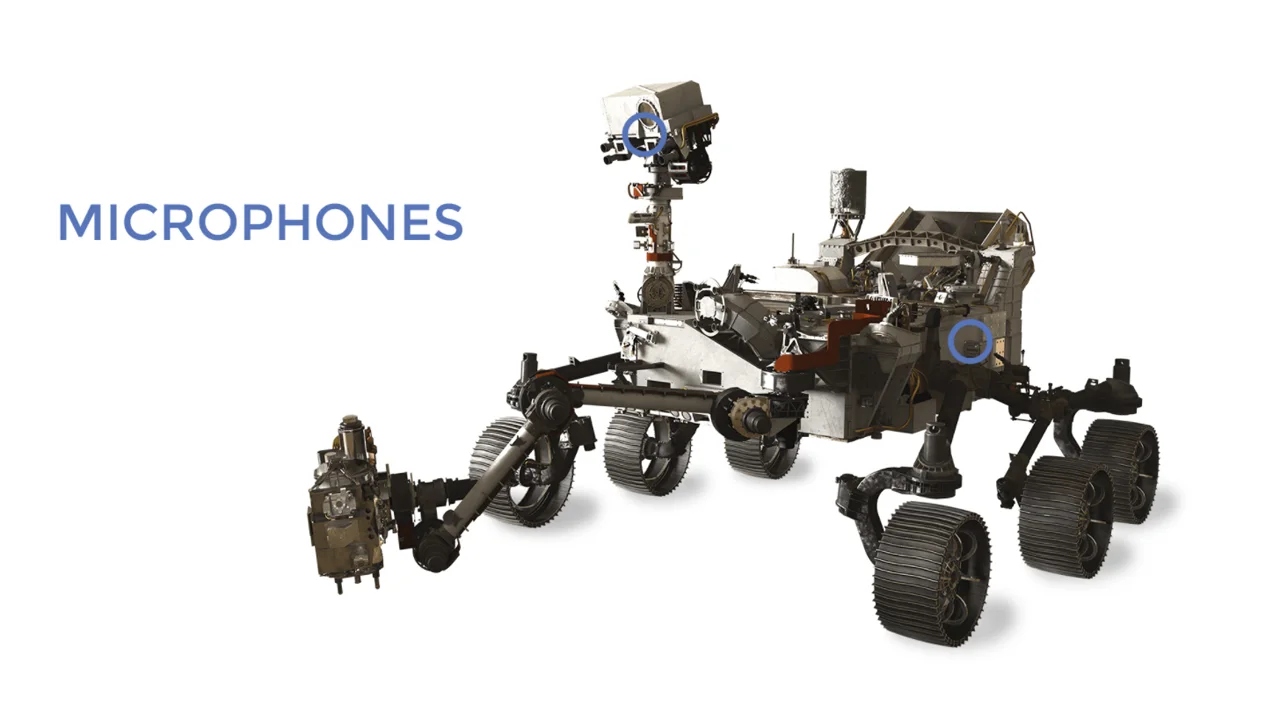
The location of Perseverance's two microphones are indicated on this digital model of the rover. Credit: NASA/JPL-Caltech
The microphone located on the chassis is specifically in place to record the sounds of the rover's entry, descent, and landing. According to NASA: "It may capture, for example, sounds of pyrotechnic devices firing to release the parachute, the Martian winds, wheels crunching down on the Martian surface, and the roaring engines of the descent vehicle as it flies safely away from the rover."
The other microphone is positioned near the SuperCam instrument on the mast. It will be used to record audio as SuperCam vaporizes rock samples or just capturing the sounds of the winds flowing across the floor of Jezero Crater.
"It is stunning all the science we can get with an instrument as simple as a microphone on Mars," Baptiste Chide, a planetary science postdoctoral researcher NASA's Jet Propulsion Laboratory, said in a NASA press release.
"Sounds on Mars are slightly different than they are on Earth because of the atmospheric composition and its properties," Chide explained. "All sounds will be lower in volume due to the low pressure. In addition, the higher-frequency tones will be strongly attenuated by the carbon dioxide molecules. All in all, it would be like listening through a wall."
Want to hear how different hearing sounds on Mars is like, compared to Earth? Turn your sound on and check out NASA's website.
"Recording audible sounds on Mars is a unique experience," Chide added. "With the microphones onboard Perseverance, we will add a fifth sense to Mars exploration. It will open a new area of science investigation for both the atmosphere and the surface."











